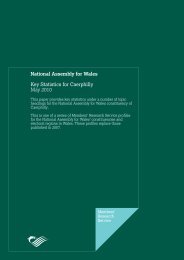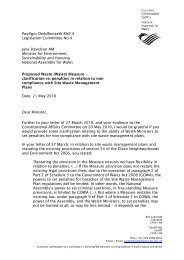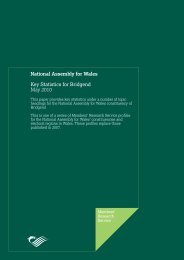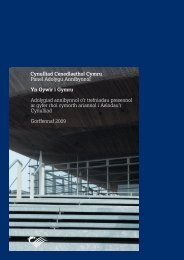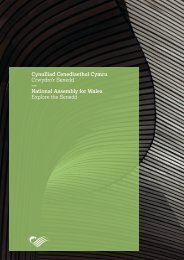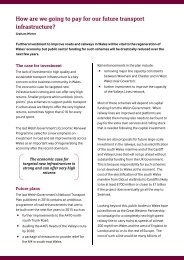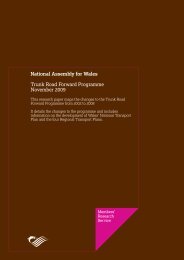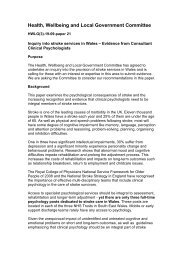Explanatory Memorandum to the Food Labelling (Nutrition
Explanatory Memorandum to the Food Labelling (Nutrition
Explanatory Memorandum to the Food Labelling (Nutrition
Create successful ePaper yourself
Turn your PDF publications into a flip-book with our unique Google optimized e-Paper software.
<strong>Explana<strong>to</strong>ry</strong> <strong>Memorandum</strong> <strong>to</strong> <strong>the</strong> <strong>Food</strong> <strong>Labelling</strong> (<strong>Nutrition</strong> Information)(Wales) Regulations 2009This <strong>Explana<strong>to</strong>ry</strong> <strong>Memorandum</strong> has been prepared by <strong>the</strong> <strong>Food</strong> StandardsAgency Wales and is laid before <strong>the</strong> National Assembly for Wales inaccordance with Standing Order 24.1.DescriptionThese Regulations implement in Wales Commission Directive 2008/100/ECwhich amends Council Directive 90/496/EEC on nutrition labelling forfoodstuffs by replacing <strong>the</strong> recommended daily allowances for vitamins andminerals in Part II of Schedule 6 <strong>to</strong> <strong>the</strong> FLRs with an updated list, byintroducing a definition of fibre in<strong>to</strong> regulation 2 and by introducing newenergy conversion fac<strong>to</strong>rs in Schedule 7 Part I.Matters of special interest <strong>to</strong> <strong>the</strong> Subordinate Legislation CommitteeNoneLegislative BackgroundThe powers enabling <strong>the</strong> Regulations <strong>to</strong> be made are contained in Sections16(1)(e) and 17(1) of <strong>the</strong> <strong>Food</strong> Safety Act 1990. These are exercisable byWelsh Ministers. The Regulations are subject <strong>to</strong> <strong>the</strong> Assembly’s negativeresolution procedure.Purpose and Intended effect of <strong>the</strong> legislationLegislative rules on nutrition labelling of foodstuffs need <strong>to</strong> be updated:• <strong>to</strong> reflect recent scientific and technological developments: Directive2008/100/EC establishes a definition of ‘fibre’, adds energy conversionfac<strong>to</strong>rs for fibre and erythri<strong>to</strong>l, updates <strong>the</strong> list of vitamins and mineralswhich may be declared and <strong>the</strong>ir recommended daily allowances;• <strong>to</strong> ensure coherence between nutrition labelling legislation and o<strong>the</strong>rlegislation; EC Regulation EC/1924/2006- The <strong>Nutrition</strong> and HealthClaims made on <strong>Food</strong>s Regulation (NHCR) and EC RegulationEC/1925/2005- <strong>the</strong> Addition of Vitamins and Minerals and of CertainO<strong>the</strong>r Substances <strong>to</strong> <strong>Food</strong>s Regulation (AVMR)The purpose of <strong>the</strong> <strong>Food</strong> <strong>Labelling</strong> (<strong>Nutrition</strong> Information) (Wales)Regulations 2009 is <strong>to</strong> amend <strong>the</strong> <strong>Food</strong> <strong>Labelling</strong> Regulations 1996 (aspreviously amended) (<strong>the</strong> FLRs) as regards <strong>the</strong> recommended dailyallowances for vitamins and minerals, introduce energy conversion fac<strong>to</strong>rs fordietary fibre and erythri<strong>to</strong>l and introduce a definition for fibre. TheRegulations will:• Create coherence between various pieces of legislation on nutritionand health claims and addition of minerals and certain o<strong>the</strong>rsubstances <strong>to</strong> foods1
• Provide industry and enforcement authorities with a clear technicalframework <strong>to</strong> work within• Provide consumers with consistent and accurate information based onup-<strong>to</strong>-date scientific evidenceBackground<strong>Food</strong> labelling is an area of European Union competence. The rules whichgovern nutrition labelling are laid out in <strong>the</strong> Council Directive 90/496/EEC on<strong>Nutrition</strong> <strong>Labelling</strong> of <strong>Food</strong>stuffs (NLD). The NLD defines <strong>the</strong> requirementsfor nutrition labelling on pre-packed foods, including technical requirements,and was implemented in<strong>to</strong> law for England, Scotland and Wales by <strong>the</strong> <strong>Food</strong><strong>Labelling</strong> Regulations 1996 (as amended), and by similar but separatelegislation for Nor<strong>the</strong>rn Ireland.<strong>Food</strong> labelling helps consumers make informed choices about <strong>the</strong> food <strong>the</strong>ybuy or consider buying. The current rules lack clarity about legalrequirements for industry and enforcement authorities. There is a need <strong>to</strong>update specific technical issues within <strong>the</strong> NLD as set out in more detailbelow.FibreNLD does not define fibre. However <strong>the</strong> Regulation EC/1924/2006 on<strong>Nutrition</strong> and Health Claims made on <strong>Food</strong>s (NHCR) lays down conditionsfor nutrition claims <strong>to</strong> be made about fibre (source of fibre, high fibre). Thereis <strong>the</strong>refore a need <strong>to</strong> define fibre <strong>to</strong> ensure <strong>the</strong>re is a consistent basis within<strong>the</strong> UK and across Europe for fibre labelling and claims.The definition of ‘fibre’ in Annex II <strong>to</strong> Commission Directive 2008/100/ECstates:“fibre” means carbohydrate polymers with three or more monomeric units,which are nei<strong>the</strong>r digested nor absorbed in <strong>the</strong> human small intestine andbelong <strong>to</strong> <strong>the</strong> following categories:- edible carbohydrate polymers naturally occurring in <strong>the</strong> food asconsumed;- edible carbohydrate polymers which have been obtained from food rawmaterial by physical, enzymatic or chemical means and which have abeneficial physiological effect demonstrated by generally acceptedscientific evidence;- edible syn<strong>the</strong>tic carbohydrate polymers which have a beneficialphysiological effect demonstrated by generally accepted scientificevidence.Energy conversion fac<strong>to</strong>rs2
The NLD defines energy conversion fac<strong>to</strong>rs; <strong>the</strong>se are required <strong>to</strong> calculate<strong>the</strong> energy present in a foodstuff. Scientific and technological advancesrelating <strong>to</strong> food ingredients mean that new energy conversion fac<strong>to</strong>rs arerequired <strong>to</strong> ensure <strong>the</strong> consumer is not misled as <strong>to</strong> <strong>the</strong> overall energycontent of some foodstuffs. Directive 2008/100/EC adds energy conversionfac<strong>to</strong>rs for fibre (2 kcal/g (8 kJ/g) and erythri<strong>to</strong>l (0 kcal/g (0 kJ/g).Vitamins and minerals and <strong>the</strong>ir recommended daily allowancesThe Annex <strong>to</strong> <strong>the</strong> NLD lists <strong>the</strong> vitamins and minerals which may be declaredas part of nutrition labelling and specifies <strong>the</strong>ir recommended dailyallowances (RDAs). The NHCR, AVMR and <strong>the</strong> <strong>Food</strong> Supplements Directive(FSD) all refer <strong>to</strong> <strong>the</strong> NLD Annex, and <strong>the</strong> RDAs listed <strong>the</strong>re, for <strong>the</strong>purposes of labelling. However <strong>the</strong>se Regulations and Directives contain afuller list of vitamins and minerals than <strong>the</strong> one currently given in <strong>the</strong> olderNLD. In order <strong>to</strong> ensure coherence with <strong>the</strong>se Regulations and Directives<strong>the</strong>re is <strong>the</strong>refore a need <strong>to</strong> update <strong>the</strong> current list of vitamins and mineralsand associated RDAs.Reason for InterventionThe nutritional composition of a food product is an essential piece ofinformation used <strong>to</strong> inform consumer choice. This legislation updates existingnutritional labelling in accordance with recent scientific opinion.Commission Directive 2008/100/EC updates certain technical aspects of NLD<strong>to</strong> recognise scientific and technological developments since 1990. It adds:• a definition of ‘fibre’• energy conversion fac<strong>to</strong>rs for fibre and <strong>the</strong> food additive erythri<strong>to</strong>l whichis a type of polyol• an updated list of vitamins and minerals which may be declared and<strong>the</strong>ir recommended daily allowances (see table below).Vitamin/mineralVitamin AVitamin DVitamin EVitamin KVitamin CThiaminRiboflavinNiacinVitamin B6Folic acidVitamin B12BiotinPan<strong>to</strong><strong>the</strong>nic acidPotassiumChlorideRecommended Daily Allowance800 μg5 μg12 mg75 μg80 mg1.1 mg1.4 mg16 mg1.4 mg200 μg2.5 μg50 μg6 mg2000 mg800 mg3
CalciumPhosphorusMagnesiumIronZincCopperManganeseFluorideSeleniumChromiumMolybdenumIodine800 mg700 mg375 mg14 mg10 mg1 mg2 mg3.5 mg55 μg40 μg50 μg150 μgThese amendments will ensure coherence between <strong>the</strong> NLD and o<strong>the</strong>rEuropean legislation, particularly <strong>the</strong> NHCR, <strong>the</strong> AVMR and <strong>the</strong> FSD). It willprovide greater legal clarity <strong>to</strong> <strong>the</strong> food industry in terms of providinginformation <strong>to</strong> consumers and will facilitate more consistent enforcement ofthis aspect of food law.These amendments may be expected <strong>to</strong> benefit industry and food lawenforcement officers.ImplementationIt is intended that <strong>the</strong>se Regulations will come in<strong>to</strong> force on 30 Oc<strong>to</strong>ber 2009.This Statu<strong>to</strong>ry Instrument applies only <strong>to</strong> Wales. Separate by parallellegislation will be made for England, Scotland and Nor<strong>the</strong>rn Ireland.Regula<strong>to</strong>ry Impact AssessmentOptionsOption 1 – do nothing - fail <strong>to</strong> implement Directive 2008/100/EC.Option 2 – implement <strong>the</strong> provisions of Directive 2008/100/EC within <strong>the</strong>timescale set out in <strong>the</strong> Directive.Option 1: Failure <strong>to</strong> implement would bring disadvantages <strong>to</strong> consumers,industry and enforcement authorities. Failure <strong>to</strong> implement would meanconsumers would not have access <strong>to</strong> certain aspects of <strong>the</strong> nutritional conten<strong>to</strong>f some foods in <strong>the</strong> market; industry would be unable <strong>to</strong> comply with all <strong>the</strong>legislation as it is not coherent; and enforcement officers would have <strong>to</strong>enforce legislation which is contradic<strong>to</strong>ry.Failure <strong>to</strong> implement would also be a risk <strong>to</strong> government in that it would resultin a serious breach of <strong>the</strong> UK’s obligations under <strong>the</strong> EC treaty and would belikely <strong>to</strong> attract infraction proceedings by <strong>the</strong> Commission against <strong>the</strong> UKunder Article 226 of <strong>the</strong> EC treaty and potential fines. O<strong>the</strong>r Member States4
could also initiate action under Article 227. Ultimately, <strong>the</strong> UK would be forced<strong>to</strong> implement.Option 2: The <strong>Food</strong> Standards Agency agrees with <strong>the</strong> rationale for amendingCommission Directive 90/496/EEC and with <strong>the</strong> requirement (in Article 2 ofCommission Directive 2008/100/EC) <strong>to</strong> bring implementing legislation in<strong>to</strong>force by 31 Oc<strong>to</strong>ber 2009. As set out in Article 2, <strong>the</strong> implementing SI willprohibit trade in non-compliant products from 31 Oc<strong>to</strong>ber 2012. This willprovide three years for re-labelling of products <strong>to</strong> ensure compliance and forredesign of labels outside of <strong>the</strong> normal redesign cycle if necessary.Costs and Benefits<strong>Food</strong> businesses affected by <strong>the</strong> implementation of Commission Directive2008/100/EC are those that market food supplements and any that choose <strong>to</strong>provide voluntary nutrition labelling, make a nutrition or health claim on aproduct or voluntarily add vitamins or minerals <strong>to</strong> foodstuffs.The energy conversion fac<strong>to</strong>rs are likely <strong>to</strong> influence products where a lowcalorie or reduced calorie claim is made and <strong>the</strong> responses <strong>to</strong> <strong>the</strong> publicconsultation indicated that <strong>the</strong> main product groups affected by changes <strong>to</strong>vitamin and mineral RDAs is likely <strong>to</strong> be Vitamin C claims for fruit juices and <strong>to</strong>food supplements generally.CostsOption 1: As this is <strong>the</strong> current legislative environment, <strong>the</strong>re are noimmediate costs/benefits. However, if this Regulation is implemented in<strong>to</strong>o<strong>the</strong>r EU Member States and <strong>the</strong> UK fails <strong>to</strong> implement, this could potentiallylead <strong>to</strong> trade barriers and lost business for UK companies; in addition it couldresult in consumer confusion. If <strong>the</strong> countries of <strong>the</strong> UK did not implement <strong>the</strong>operative provisions of <strong>the</strong> Directive this would lead <strong>to</strong> infraction proceedings(as described above) and would lead <strong>to</strong> a significant cost <strong>to</strong> government.Option 2: costs are outlined below.Costs <strong>to</strong> food businesses for re-labelling and analysisThe main direct potential cost <strong>to</strong> food businesses would be a necessarylabelling change. The average labelling cost of £1,000 per SKU (S<strong>to</strong>ckKeeping Unit – A food product with its own unique barcode) has been widelyaccepted during previous consultations with industry. This is an average figureused for aggregation because <strong>the</strong> costs vary widely in re-labelling dependentupon: <strong>the</strong> medium a label is printed on, <strong>the</strong> colours used and whe<strong>the</strong>r <strong>the</strong>label requires a plate change, amongst o<strong>the</strong>r fac<strong>to</strong>rs. However, given <strong>the</strong>three-year transition period, it is assumed that most products will be relabelledwithin this period and <strong>the</strong>refore <strong>the</strong> labelling changes will be absorbed withinnormal product re-labelling cycles. The majority of consultation responses5
have agreed with this assumption that <strong>the</strong> transition time is sufficient <strong>to</strong> makeany adjustments within normal business re-labelling cycles.There may be some costs associated with erythri<strong>to</strong>l analysis and fibreanalysis for companies <strong>to</strong> correctly label <strong>the</strong>se food components. We will notbe able <strong>to</strong> determine whe<strong>the</strong>r <strong>the</strong>re will be costs associated with <strong>the</strong>recommended methods of analysis for fibre until we know what <strong>the</strong>se are. In<strong>the</strong> case of fibre, <strong>the</strong> FSA will maintain its current guidance until EuropeanCommission guidance is adopted (see paragraph under benefits below). Inthis regard <strong>the</strong> European Commission in July 2009 circulated a working paperon <strong>the</strong> subject for discussion with Member States later in 2009.We assume that, given <strong>the</strong> three-year transition period, any direct incrementalcosts associated with implementation of Commission Directive 2008/100/ECwill be low, apart from a small potential cost for erythri<strong>to</strong>l and fibre analysisand that associated with reading and understanding <strong>the</strong> new legislation.Costs associated with loss of nutritional claimsA secondary effect <strong>to</strong> food businesses, following a labelling change causedby <strong>the</strong> proposed regulations, could be <strong>the</strong> loss of nutritional claims asidentified in some of <strong>the</strong> consultation responses. A lost nutritional claim mayresult in a potential loss in sales or in costs <strong>to</strong> mitigate this loss in sales suchas product re-positioning or reformulation. Although <strong>the</strong> Agency recognises<strong>the</strong>se costs <strong>to</strong> businesses, <strong>the</strong>re is currently insufficient evidence <strong>to</strong> make areasonable cost estimate. We understand from <strong>the</strong> responses that <strong>the</strong>majority of <strong>the</strong>se costs arising from <strong>the</strong> nutritional claim will be marketingcosts associated with product positioning and product communication.Costs of new fibre analysis methodThere may be costs associated with putting in place new methods of analysisfor fibre, however we will not be able <strong>to</strong> determine whe<strong>the</strong>r this is so until weknow what <strong>the</strong> recommended methods of analysis for fibre are.FamiliarisationThere is a <strong>to</strong>tal familiarisation cost of approximately £207,000 for <strong>the</strong> wholeof <strong>the</strong> UK. This breaks down, using VAT registered business data 1 <strong>to</strong>approximately: £166,000 in England, £22,000 in Scotland, £11,000 in Walesand £8,000 in Nor<strong>the</strong>rn Ireland (all rounded <strong>to</strong> nearest £1000).The tablebelow summarises <strong>the</strong> familiarisation costs <strong>to</strong> both industry and localauthorities, split by England, Scotland, Wales and Nor<strong>the</strong>rn Ireland. 21 Ibid2 All figures are rounded <strong>to</strong> <strong>the</strong> nearest £1000 and one decimal place, <strong>the</strong>refore £161.9 represents£161,900 (rounded).6
£,000s England Scotland Wales N.Ireland UKIndustry £161.9 £21.9 £10.7 £7.8 £202.3LAs £3.9 £0.3 £0.2 £0.3 £4.7Total £165.8 £22.2 £10.9 £8.1 £207.0Familiarisation methodology: Costs <strong>to</strong> enforcement officersIn terms of reading and understanding <strong>the</strong> new legislation, <strong>the</strong> FSA estimatesa time of 30 minutes per local authority (LA) <strong>to</strong> be realistic. This equates <strong>to</strong> acost per LA of £10.00 (all figures are rounded). This figure is taken from <strong>the</strong>2008 ONS ASHE (Annual Survey of Hours and Earnings) figures for PublicService Professionals of £15.40 per hour (median value), which, in-line with<strong>the</strong> Standard Cost Model, is <strong>the</strong>n up-rated by 30% <strong>to</strong> account for overheads,<strong>to</strong> give a figure of £20.00 per hour. 3 Divided by two for half an hour, gives£10.00. There are 469 4 LAs in <strong>the</strong> UK who will need <strong>to</strong> read <strong>the</strong> newlegislation: £10.00 x 469 yields a one-off familiarisation cost of approximately£4,700 (£220 for Wales).Familiarisation methodology: Costs <strong>to</strong> food businessesIn terms of reading and understanding <strong>the</strong> new legislation, <strong>the</strong> FSA estimatesa time of 30 minutes per business <strong>to</strong> be realistic. This equates <strong>to</strong> a cost perbusiness of £7.50 (all figures are rounded) This figure is taken from <strong>the</strong> 2008ONS ASHE (Annual Survey of Hours and Earnings) figures for Managers inDistribution, S<strong>to</strong>rage and Retailing of £11.59 per hour (median value), which,in-line with <strong>the</strong> Standard Cost Model, is <strong>the</strong>n up-rated by 30% <strong>to</strong> account foroverheads, <strong>to</strong> give a figure of £15.06 per hour. Divided by two for half an hour,gives £7.53.There are 9,865 food related manufacturing premises and 43,830 nonspecialisedfood retailer premises registered in <strong>the</strong> UK. 5 Both figures includebusinesses, which will not need <strong>to</strong> read <strong>the</strong> legislation (approximately 28,000of <strong>the</strong> businesses above have less than 5 employees), in <strong>the</strong> absence ofaccurate estimates on how many businesses <strong>the</strong> legislation will affect a midpoin<strong>to</strong>f 26,848 is assumed. If <strong>the</strong>y all need <strong>to</strong> read <strong>the</strong> legislation this willequate <strong>to</strong> 26,848 x £7.53 which yields a one-off familiarisation cost estimatedat approximately £202,000 for <strong>the</strong> whole of <strong>the</strong> UK (£10.700 for Wales). Thisis likely <strong>to</strong> be an overestimate, as <strong>the</strong> nutritional labelling updates are specific<strong>to</strong> food product groups.3 Annual Survey of Hours and Earnings is available from ONS at:http://www.statistics.gov.uk/statBase/product.asp?vlnk=131014As local authorities have many different enforcement systems in place many enforcement officers havemultiple duties; we have maintained our initial estimate of 469 LAs needing <strong>to</strong> read and understand <strong>the</strong>new legislation.5 Taken from <strong>the</strong> category ‘manufacturer of food products and beverages’ and ‘Retail sale in nonspecialiseds<strong>to</strong>res with food, beverages or <strong>to</strong>bacco predominating’ ONS: TABLE A3.1 UNITEDKINGDOM - NUMBER OF LOCAL UNITS in VAT and/or PAYE BASED ENTERPRISES in 2008. Usingpremise data ra<strong>the</strong>r than businesses is likely <strong>to</strong> over-estimate familiarisation costs (as legislation is likely<strong>to</strong> be read per business ra<strong>the</strong>r than per premise) but premises are used <strong>to</strong> be consistent with <strong>the</strong>previous consultation.7
Administrative Burden Costs<strong>Labelling</strong> is an administrative burden on business. However, with <strong>the</strong>proposed 3-year transition period any changes should generally be withinbusinesses normal commercial re-labelling cycle and so no additional burdensshould result from implementing option 2.Corporate communication costsLarger businesses that carry nutritional information on <strong>the</strong>ir websites or aspart of <strong>the</strong>ir promotional material may also incur a labour cost in updating<strong>the</strong>m in light of <strong>the</strong> new regulations. There may also be an increase inconsumer enquiries. However, <strong>the</strong>se costs are unlikely <strong>to</strong> affect a largeproportion of <strong>the</strong> potentially 26,800 businesses affected and <strong>the</strong>re isinsufficient evidence <strong>to</strong> make accurate cost estimates.BenefitsOption 1: failure <strong>to</strong> implement would not bring any benefits <strong>to</strong> consumers,industry, enforcement authorities or government.Option 2: benefits are outlined belowBenefits <strong>to</strong> consumersAt present, <strong>the</strong>re are no legislative controls on <strong>the</strong> definition of ‘fibre’ for foodlabelling purposes nor on <strong>the</strong> methods of analysis <strong>to</strong> be used in determining<strong>the</strong> fibre content of food products. The FSA has issued guidance on methodsof analysis. However, food business opera<strong>to</strong>rs are not compelled <strong>to</strong> follow thatguidance <strong>to</strong> satisfy <strong>the</strong>mselves of <strong>the</strong> fibre content of food products and, as aresult, claims on different products may relate <strong>to</strong> different forms of fibre withvarying (or no) proven human health benefits.Once <strong>the</strong>re are clear recommendations about <strong>the</strong> methods of analysis for fibre<strong>to</strong> be used in relation <strong>to</strong> food labelling (see below) <strong>the</strong>re should be a clearbenefit of applying a consistent definition since consumers will be betterinformed about <strong>the</strong> fibre content of foods <strong>the</strong>y buy or consider buying.Benefit <strong>to</strong> food businesses and <strong>to</strong> enforcement officersBy providing a definition of ‘fibre’ <strong>the</strong> new legislation aims <strong>to</strong> provide clarity interms of how claims about fibre relate <strong>to</strong> <strong>the</strong> fibre content of a food; ultimatelythis will be a benefit for <strong>the</strong> food industry and for enforcement officers.However, <strong>the</strong> legislation does not link <strong>the</strong> ‘functional’ definition of fibre <strong>to</strong>methods of analysis, <strong>the</strong>reby leaving some uncertainty for food businessopera<strong>to</strong>rs and enforcement officers at present. The European Commissionagreed <strong>to</strong> produce guidance on suitable methods of analysis for fibre and inJuly 2009 circulated a working paper on <strong>the</strong> subject for consideration by EU8
member states. However, until this is agreed with EU member states <strong>the</strong>uncertainty remains.ConsultationThe <strong>Food</strong> Standards Agency Wales carried out a 12 week public consultationon <strong>the</strong> draft Regulations and impact assessment which ran from 6 March <strong>to</strong> 29May 2009. A list of those consulted can be found at Annex 1. Parallelconsultations were conducted in England, Scotland and Nor<strong>the</strong>rn Ireland.Stakeholders including consumer and health professional groups,manufacturers and food industry bodies, enforcement bodies, individuals andgovernment departments were consulted. The consultation package was alsoposted on <strong>the</strong> Agency’s website.Reponses <strong>to</strong> this consultation were generally in agreement with <strong>the</strong> costassumptions included in <strong>the</strong> draft impact assessment. The impact onbusiness, charities or voluntary bodies will be minimal as <strong>the</strong> transition periodwill provide three years for re-labelling of products <strong>to</strong> ensure compliance andfor redesign of labels outside of <strong>the</strong> normal redesign cycle if this is necessary.One concern raised by a number of stakeholders related <strong>to</strong> <strong>the</strong> continued lackof agreed analytical methodology for fibre. The European Commission (EC)has indicated that it plans <strong>to</strong> introduce guidance on suitable methods ofanalysis and has recently circulated a discussion paper <strong>to</strong> Member States.The FSA will engage in <strong>the</strong>se discussions with <strong>the</strong> EC and o<strong>the</strong>r MemberStates <strong>to</strong> ensure that appropriate European guidance is developed as soon aspossible.Additionally some stakeholders indicated that <strong>the</strong> transition period of 3 yearsmay not be long enough <strong>to</strong> mitigate <strong>the</strong> impact of <strong>the</strong>se new rules for allproducts, and in particular some longer shelf life foods, such as foodsupplements. However <strong>the</strong> majority of manufacturers of such productsagreed <strong>the</strong>y will be able <strong>to</strong> deal with <strong>the</strong>se changes via usual relabellingcycles.One response <strong>to</strong> <strong>the</strong> consultation in Wales was received from Hybu CigCymru – Meat Promotion Wales (HCC) who had no comment <strong>to</strong> make.Post Implementation ReviewTrade in products that do not comply with <strong>the</strong> new rules will be prohibitedfrom 31 Oc<strong>to</strong>ber 2012. The effects of <strong>the</strong> legislation will be reviewed inOc<strong>to</strong>ber 2015 at <strong>the</strong> latest.SummaryIn summary, <strong>the</strong>se Regulations will ensure coherence between <strong>the</strong> NLD ando<strong>the</strong>r European legislation, particularly EC Regulation 1924/2006 on <strong>Nutrition</strong>and Health Claims made on <strong>Food</strong>s, EC Regulation 1925/2005 on <strong>the</strong> Additionof Vitamins and Minerals and of Certain O<strong>the</strong>r Substances <strong>to</strong> <strong>Food</strong>s (<strong>the</strong>AVMR) and Commission Directive 2002/46/EC on <strong>Food</strong> SupplementsDirective. It will provide greater legal clarity <strong>to</strong> <strong>the</strong> food industry in terms of9
providing information <strong>to</strong> consumers and will facilitate more consistentenforcement of this aspect of food law.Failure <strong>to</strong> make <strong>the</strong>se Regulations would result in a serious breach of <strong>the</strong>UK’s obligations under <strong>the</strong> EC treaty which would attract infractionproceedings by <strong>the</strong> Commission against <strong>the</strong> UK and <strong>the</strong> possibility of heavyfines.Stakeholders consulted:3M Health Care LtdAbergavenny Fine <strong>Food</strong>s LtdADAS WalesAll Wales Dietetic Advisory CommitteeAllison's Celebration CakesAssociation of Voluntary OrganisationsAvana Bakeries limitedAWDACB A Jenkins & SonsB Sidoli & Sons LtdBar & Restaurant <strong>Food</strong>s LtdBarons PatisserieBerwyn BakeryBraces Bakery LimitedBritish Heart FoundationBriwsionBusiness EyeCapita SymondsCardiff Scientific ServicesCardiff UniversityCarolin's Real Bread CoChildren's Commissioner for WalesChildren's Information ServiceCongenital Anomaly Register & Information ServiceConsumer Focus WalesConway and Denbiglishire Local Public Health TeamCountry land & Business AssociationDairy Development CentreDEE DAIRY SERVICESDental Public Health UnitDepartment of Dental Health and Biological ScienceEducation Development Inclusion ServiceAnnex 110
Farm Assured Welsh Lives<strong>to</strong>ckFederation of Small Businesses (South Wales)fedwen Bakerys (Cardigan) LtdFlying Start<strong>Food</strong> Centre Wales<strong>Food</strong> ConsultancyFriends of <strong>the</strong> Earth CymruFSA Advisory Committee for WalesG C Hahn & Co LtdGarth Bakeries LtdGlutafinGood <strong>Food</strong> Distribu<strong>to</strong>rsGrassland Development Centre, IGERGreggs WalesHAT EventsHealth Protection AgencyHenllan BreadHybu Cig Cymru - Meat Promotion WalesIceland <strong>Food</strong>s LimitedInstitute of Biological & Environmental ServicesJM & A hughes (Station Bakery)Lewis' Pies LtdLocal Helth Watch GroupLynn S<strong>to</strong>ckley and AssociatesMedia WalesMemory Lane Cakes LtdMeridian <strong>Food</strong>s LtdMin<strong>to</strong>n Treharne Davies LtdMontgomery Spring Water CoNational Assembly for WalesNational Farmers Union CymruNational Federation Of Women's InstitutesNational Public Health Service WalesNFU CymruNorth Wales NHS TrustNPHSOgmore Vale Bakery LimitedOrganic Centre WalesOrganic Working GroupPantycelyn Comprehensive SchoolPeters <strong>Food</strong> ServiceRachel's OrganicRCGP WalesRiverside Community Market Association Social EnterpriseLtd11
Royal Welsh Agricultural SocietySlaters BakerySnowdrop BakerySouth Caernarfon CreameriesTan y CastellThe Bay (Public Affairs ltd)The Co-operative GroupThe Monmouthshire Rural Business CentreThe Village Bakery (Coedpoeth) LimitedTillery Valley <strong>Food</strong>s LtdTrading Standards Institute (Wales)Unilever UK LtdUniversity of BangorUniversity of Wales in CardiffUWICVydex Corporation LtdWales Council for Voluntary ActionWelsh Assembly governmentWelsh <strong>Food</strong> AllianceWelsh Hills BakeryWelsh Organic SchemeWelsh Quality MeatsWhite's Golden Crust BakeryZorba <strong>Food</strong>s12
Annex 2TRANSPOSITION NOTE: The <strong>Food</strong> <strong>Labelling</strong> (<strong>Nutrition</strong> Information)(Wales) Regulations 2009This transposition note indicates how Commission Directive 2008/100/ECwhich amends Directive 90/496/EEC on nutrition labelling will be transposedin<strong>to</strong> legislation in Wales by The <strong>Food</strong> <strong>Labelling</strong> (<strong>Nutrition</strong> Information) (Wales)Regulations 2009, which amend <strong>the</strong> <strong>Food</strong> <strong>Labelling</strong> Regulations 1996.Responsibility for implementation in Wales lies with <strong>the</strong> Minister for Health andSocial Services on <strong>the</strong> advice of <strong>the</strong> <strong>Food</strong> Standards Agency, save whereindicated in <strong>the</strong> table below.CommissionLegislation andArticleObjective Implementation ResponsibilityCommissionDirective2008/100/ECArticle 1 (1), 1 (4)and Annex IICommissionDirective2008/100/ECArticle 1 (2)CommissionDirective2008/100/ECArticle 1 (3) andAnnex ICommissionDirective2008/100/ECArticle 2Introduction ofdefinition of fibreIntroduction of energyconversion fac<strong>to</strong>rs forfibre and erythri<strong>to</strong>lReplaces andcompletes list ofrecommended dailyallowances forvitamins and mineralsTo prohibit trade inproducts which do notcomply with Directivefrom 31 Oc<strong>to</strong>ber 2012Regulation 2(2)(b)Regulation 2 (5)Regulation 2(3) &(4)Regulation 313



